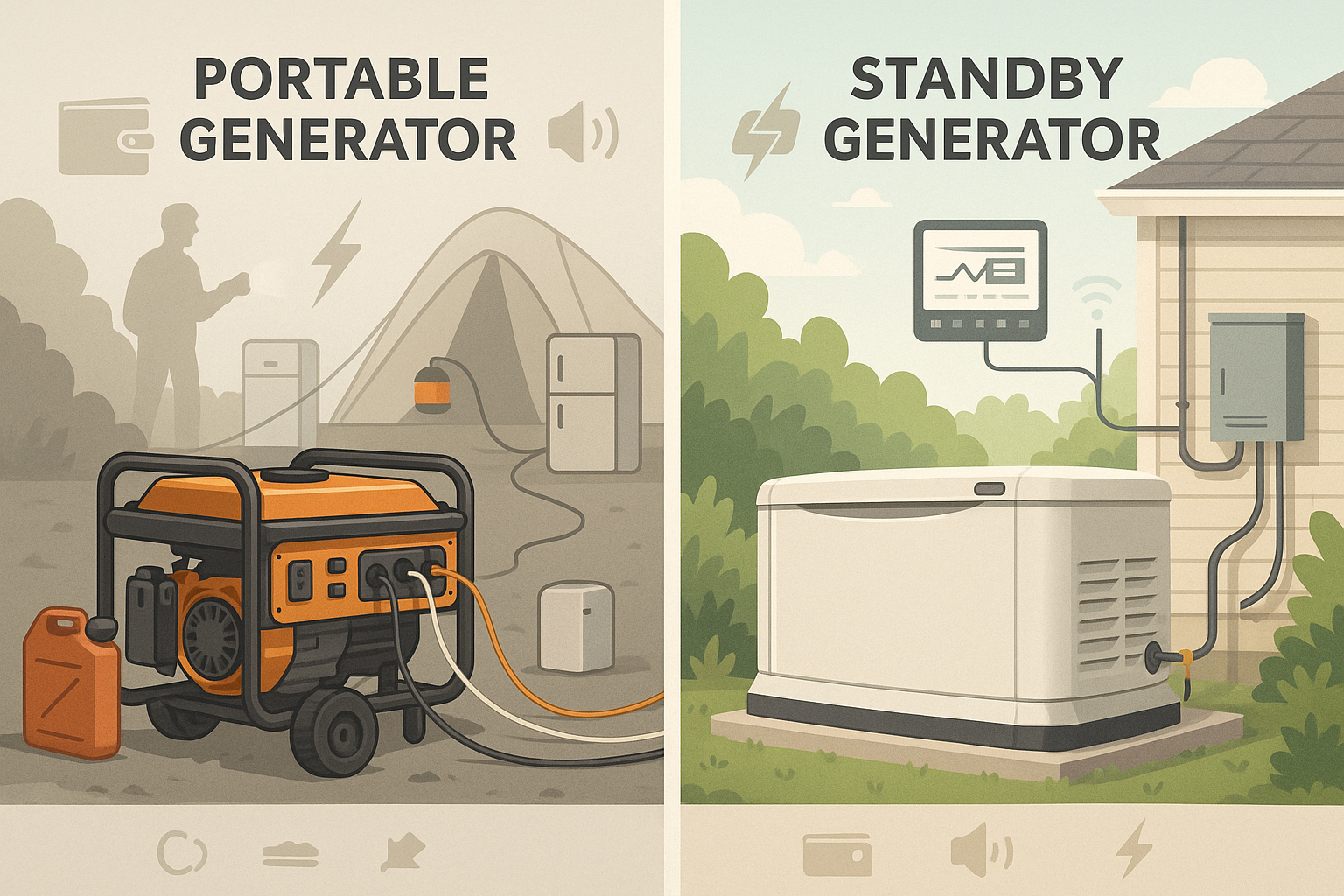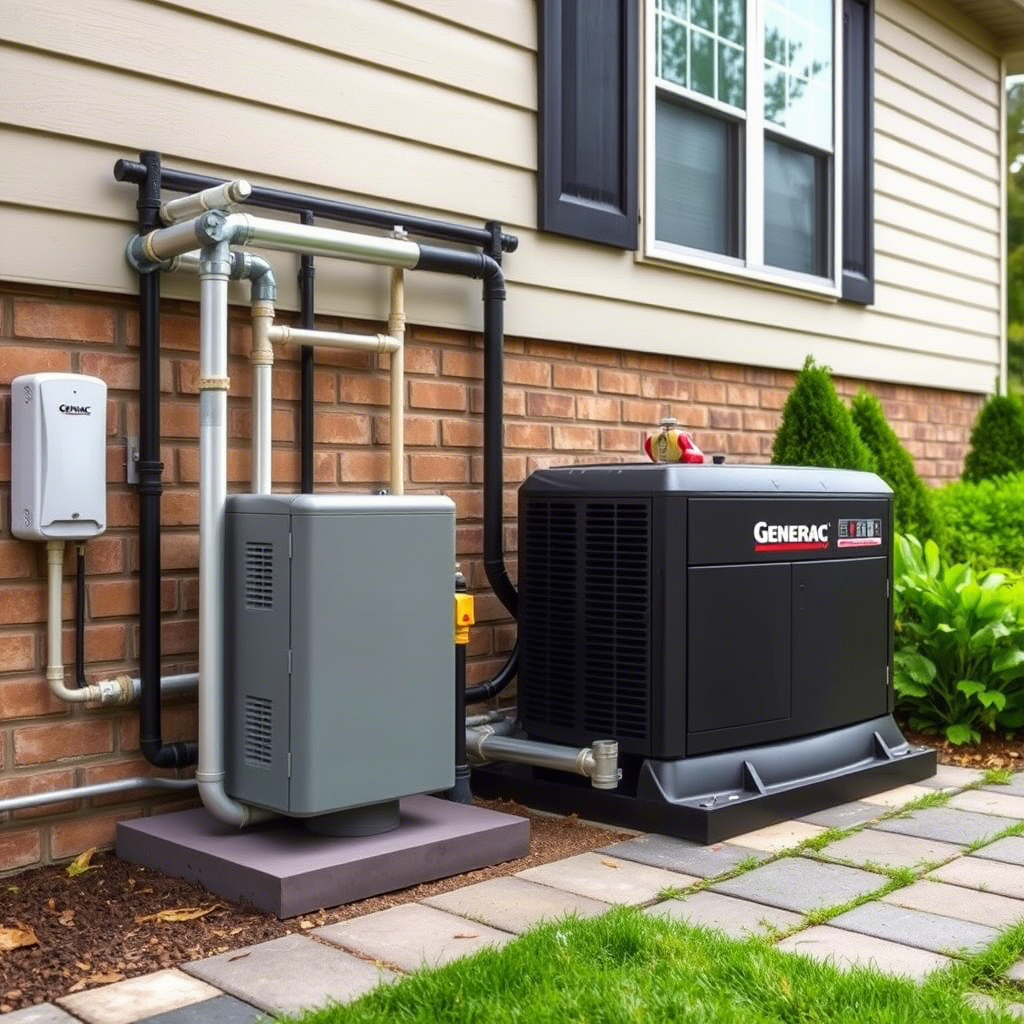Portable vs. Standby Generators: Pros, Cons, and Best Use Cases (2025 Guide)
Power outages are unpredictable and can disrupt daily life. Whether caused by severe weather, grid failures, or natural disasters, having a reliable backup power source is essential. But when choosing between portable and standby generators, how do you decide which one suits your needs best?
This guide dives deep into the differences, advantages, disadvantages, and ideal use cases of each type of generator. We’ll also cover costs, safety considerations, top models for 2025, and frequently asked questions to help you make an informed decision.
What’s the Difference Between Portable and Standby Generators?
Portable Generators
- What They Are: Compact, mobile power sources designed for temporary use. They typically run on gasoline, propane, or diesel.
- How They Work: Require manual setup—start the engine, connect appliances via extension cords, or use a transfer switch for larger loads.
- Best For:
- Outdoor activities like camping, tailgating, or RV trips.
- Emergency backup for critical appliances (e.g., refrigerator, lights, medical devices).
- Job sites or remote locations where electricity isn’t readily available.
Standby Generators
- What They Are: Permanent backup systems installed outside your home and connected directly to your electrical panel.
- How They Work: Automatically detect power outages and restore electricity within seconds without human intervention.
- Best For:
- Whole-home power during extended blackouts.
- High-wattage appliances like HVAC systems, sump pumps, and electric stoves.
- Homeowners in regions prone to frequent or prolonged power outages.
Key Comparisons: Portable vs. Standby Generators
| Feature | Portable Generators | Standby Generators |
|---|---|---|
| Cost | $500–$3,000 | $3,000–$15,000+ (plus installation) |
| Power Output | 1,000–12,000 watts | 7,000–24,000+ watts |
| Installation | Plug-and-play | Requires professional setup |
| Fuel Type | Gasoline, propane, diesel | Natural gas, propane, diesel |
| Runtime | 8–24 hours (requires refueling) | Days to weeks (continuous fuel supply) |
| Noise Level | 65–85 dB (loud) | 60–70 dB (quieter) |
| Maintenance | Manual upkeep (oil changes, etc.) | Self-testing, low maintenance |
| Best Use Case | Temporary/emergency power | Whole-home automatic backup |
Pros and Cons Breakdown
Portable Generators: Advantages
- Affordable: Low upfront cost makes them ideal for occasional use.
- No Installation Required: Simply add fuel and plug in devices.
- Portable Design: Lightweight and easy to transport for outdoor adventures, job sites, or multiple homes.
- Dual-Fuel Options: Many models offer flexibility with gasoline and propane operation.
Portable Generators: Disadvantages
- Manual Operation: You must manually start and connect the generator during an outage.
- Limited Runtime: Frequent refueling required, especially during long outages.
- Noisy: Loud operation may disturb neighbors or make it unsuitable for nighttime use.
- Power Limitations: Typically insufficient to power an entire house, especially large appliances.
Standby Generators: Advantages
- Automatic Power Restoration: Kicks on within seconds of detecting an outage.
- Higher Capacity: Can handle whole-house loads, including energy-intensive systems like HVAC and water heaters.
- Extended Runtime: Connected to natural gas or propane lines for continuous operation.
- Quieter Operation: Enclosed design reduces noise pollution.
Standby Generators: Disadvantages
- Expensive: High initial investment plus installation costs.
- Permanent Installation: Once installed, it cannot be moved or repurposed.
- Professional Maintenance Needed: Annual servicing ensures optimal performance but adds to ongoing costs.
Best Use Cases for Each Type
When to Choose a Portable Generator
- Camping/RVs: Lightweight and compact models like the Honda EU2200i or Jackery Solar Generator provide quiet, efficient power for outdoor enthusiasts.
- Emergency Backup: Powers essential appliances such as refrigerators, lights, and phone chargers (Firman 3650W).
- Construction Sites: High-wattage options like the Generac GP6500 deliver reliable power for tools and equipment.
When to Choose a Standby Generator
- Frequent Outages: Automatic backup systems like the Generac Guardian 24kW ensure uninterrupted power during storms or grid failures.
- Medical Needs: Keeps life-supporting devices like oxygen machines and CPAPs operational.
- Luxury Homes: Supports smart home systems, pools, and other high-demand amenities (Kohler 24kW).
Cost Comparison: Upfront vs. Long-Term
| Expense | Portable | Standby |
|---|---|---|
| Unit Cost | $500–$3,000 | $3,000–$15,000+ |
| Installation | $0 (DIY) | $1,500–$5,000 |
| Fuel Costs | $20–$50/day (gas) | $5–$20/day (natural gas) |
| Maintenance | $50/year (oil changes) | $200–$500/year |
Verdict:
- Portable Generators: Cheaper short-term, but higher long-term fuel costs.
- Standby Generators: Significant upfront investment, but lower operating costs over time.
Safety & Installation Considerations
Portable Generator Safety Tips
- ⚠ Never Run Indoors: Risk of carbon monoxide poisoning is extremely high.
- ⚠ Use Heavy-Duty Extension Cords: Avoid overheating and fire hazards.
- ⚠ Install a Transfer Switch: Prevents backfeeding into the grid, which could endanger utility workers.
Standby Generator Installation
- 🔧 Requires Permits: Local building codes and electrical regulations apply.
- 🔧 Proper Placement: Must be installed on a concrete pad with adequate ventilation.
- 🔧 Hire a Professional Electrician: Wiring into your home’s electrical panel is complex and should not be attempted DIY.
Top Models in 2025
Best Portable Generators
- Honda EU2200i: Quiet, fuel-efficient, and reliable (2,200W).
- Generac GP3500iO: Inverter technology provides clean power for sensitive electronics.
- Champion 3800W Dual Fuel: Versatile dual-fuel capability (gasoline and propane).
Best Standby Generators
- Generac Guardian 24kW: Features Wi-Fi monitoring for real-time updates.
- Kohler 20RESCL: Commercial-grade reliability and durability.
- Briggs & Stratton 12kW: Affordable yet powerful option for home backup.
Final Verdict: Which Should You Buy?
Choose a Portable Generator If:
- You need temporary or mobile power.
- Your budget is under $3,000.
- You only need to run essential appliances.
Choose a Standby Generator If:
- You want automatic, whole-home backup.
- You live in an area with frequent or prolonged outages.
- You’re willing to invest $5,000+ for permanent power solutions.
9. FAQ
Q: Can a portable generator power a whole house?
A: No—most max out at 8,000–12,000W, enough for essentials but not HVAC systems or central air conditioning.
Q: How long do standby generators last?
A: With proper maintenance, they typically last 15–30 years.
Q: Are solar generators a good alternative?
A: Yes—for small loads and eco-friendly applications—but they have limited runtime compared to fuel-based models.
10. Conclusion
Choosing between portable and standby generators depends on your specific needs, budget, and circumstances. Portable generators are affordable, versatile, and great for emergencies, while standby generators provide seamless, high-capacity power for extended outages.
Need personalized advice? Share your situation in the comments below, and we’ll help you find the perfect solution!



